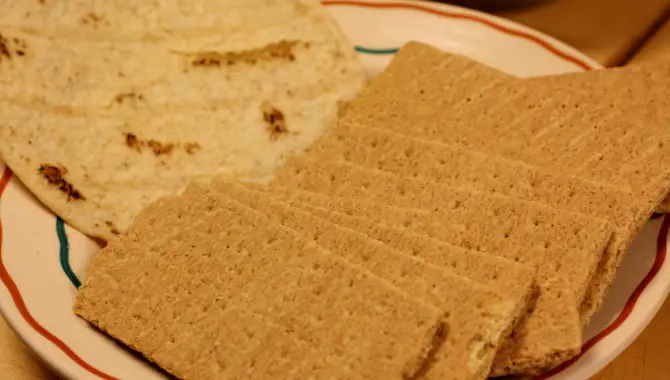Graham crackers are one of those classic foods that many people enjoy. Originating in the US, the sweet-tasting wheat crackers have become popular elsewhere in the world too. Graham crackers are often eaten alone or with a topping; they’re also widely used in lots of tasty recipes, from the classic S’mores to pies and cakes. As a vegan, you will want to make sure that your favourite treats are free from any ingredients that have an animal origin but you still want your food to taste good. Many vegans wonder if they can still enjoy familiar foods like graham crackers.
Are graham crackers vegan? Graham crackers often contain ingredients, such as honey, that are not vegan. Some graham crackers contain controversial ingredients that some vegans reject while others regard as acceptable. If you’re vigilant about checking the ingredient lists, however, you will find vegan versions of this popular snack.
Perhaps you’re a recent vegan and you’re looking for snacks that are suitable for your new diet. Maybe you’re well established in a vegan lifestyle but you want to try something a little different. Either way, you’ve arrived on this page because you have questions about graham crackers and whether they’re appropriate for vegans.
- Do graham crackers contain animal ingredients?
- What other, similar crackers are okay for a vegan diet?
- And perhaps most pressingly, can vegans make graham cracker S’mores?
Keep reading to find out the answers to these questions and more. We have the information you’re looking for.
Are Graham Crackers Vegan?
There’s no simple answer to this question. Graham crackers certainly can be vegan, but you need to keep a close eye on the ingredients. Graham crackers are sometimes made with ingredients that are decidedly not acceptable for a vegan lifestyle. They may also be made with ingredients that, while not explicitly animal-derived, may be controversial in the vegan community for other reasons. Let’s start by looking at what a graham cracker is made from.
The distinguishing characteristic of the original graham cracker was the flour used to make it. Graham flour is a type of coarsely ground whole-wheat flour. Unlike regular whole-wheat flour, graham flour is not sifted and retains lots of texture, making for a heartier cracker.
The flour takes its name from one Sylvester Graham, a 19th-century dietary reformer and member of the temperance movement. Graham objected to highly refined foods, which he saw as both lacking in nutrients and contributing to moral decline. It was this conviction that encouraged Graham to come up with his original cracker. This was very different from the ones eaten today. Sylvester Graham believed that foods needed to be kept as bland as possible in order to avoid encouraging vice, and so his crackers were specifically designed to be tasteless. The first graham crackers contained no flavourings and only a small amount of molasses, for nutrition rather than sweetness. Sylvester Graham ate a near-vegan diet himself and so the earliest recipes did not contain any animal ingredients.
Later on, the potential of graham crackers as a popular snack was recognised. The studiedly bland formula was not appealing for newer generations of consumers, who no longer cleaved to Sylvester Graham’s abstemious ideas but who still wanted good nutrition. Honey was added to make the snacks more palatable and the recipe was changed significantly, although coarse, high-fibre wheat flour was still used. Where proper graham flour was hard to come by or regarded as less appealing to consumers, it was replaced with unbleached wheat flour that was mixed with bran to create a similar texture. Over time, new varieties were introduced. These included cinnamon flavoured graham and graham-style crackers made with non-wheat flour.
Today, you can find any number of products termed “graham crackers”. They don’t necessarily bear much resemblance to the earliest versions but all have characteristics like a satisfying texture and a slightly sweet taste. While many varieties — particularly honey grahams — are not vegan, there’s no reason that graham crackers cannot be made with completely vegan ingredients. This makes graham crackers a potentially valuable addition to a vegan’s diet since they are fairly nourishing. Graham crackers contain useful protein, something that vegans need to watch out for.
I personally like to keep a box or two of graham-style crackers around. They’re great for a snack or recipes. Graham crackers can be crushed to make a pie crust for your vegan faux cheesecake, crumbled into your soy yoghurt for additional fibre, or turned into everything from a savoury treat to a sweet dessert. They’re an excellent cupboard staple if your diet happens to include wheat.
Are graham crackers healthy?
The answer here will tend to be a bit equivocal. Vegan graham crackers are certainly a lot better for you than a cracker made with white flour or animal products. As we’ve already noted, they pack in a lot of fibre which is essential for your digestion. Graham flour may also be fortified with vitamins that are useful to vegans, such as the elusive vitamin B group. Graham flour is also high in protein, with graham flour bread packing in over 12 per cent protein. That’s good news.
The bad news is that you’re still consuming a heavily processed foodstuff. The closer to unprocessed the better, generally, and although graham flour is less processed than white flour it’s not good to have too much.
Another issue is that graham crackers are often heavily sweetened with sugar and other substances. Not only might this compromise their vegan status (depending on your standards, some sugar is not cruelty-free), it also makes them much less good for you. Unfortunately, food manufacturers have worked out that they can sell people extravagant quantities of fat and sugar as a health food if they add enough fibre. Be on the alert and go for a less sweet graham brand.
Graham crackers aren’t terrible but they are definitely something to consume in moderation. Don’t eat them with every meal and try to combine them with healthier ingredients. Graham crackers are really great topped with a creamy vegan spread and lots of fresh berries or slices of cucumber. If you can find a less heavily sweetened brand (or make your own) you can also enjoy them with vegan paté and fresh vegetable crudites. Most people think of them as something to eat with sweeter foods but I find the slight sweetness of graham makes them an interesting foil for savoury toppings.
Of course, if your diet doesn’t include wheat (for example because you’re gluten-free), you should avoid most graham crackers as they are wheat-based. That said, you don’t have to miss out. Similar crackers made with rice or other flours are also available and they’re just as versatile and tasty. I like to make brown rice graham style crackers once in a while, just for a change and also to give my gluten-free friends.
Can S’mores be vegan?
This is the question many people will be mulling over. The answer, fortunately, is yes. Fully vegan S’mores can be a bit of a challenge but not an insurmountable one. The classic campfire treat calls for milk chocolate and marshmallows, which are typically made with the dreaded gelatin. However, all is not lost. If you’re looking for something to snack on as a vegan, S’mores can be put back on the menu with a couple of easy substitutions.
First of all, you’ll need to make sure that your graham crackers are completely vegan. They’ll need to be free from honey and any other dubious ingredients. Luckily this isn’t too hard, as vegan graham crackers are easy to find (and almost as easy to make).
The next ingredient is chocolate. Dairy-free chocolate is also pretty easy to find. If you want a creamier taste, you can find chocolate made with coconut or other vegetable milk. Don’t forget to make sure your chocolate is organic and fair trade. If you’re concerned about cruelty-free ingredients, look for a chocolate that specifies non-bone-char sugar. I’m a fan of Green & Black’s organic chocolates, which come in a range of different flavours. They’re all good.
For the marshmallow, I recommend either Dandies marshmallows in the US or Freedom Confectionery Mini Mallows in the UK. If neither of those brands presents itself, hunt around your local organic and vegan speciality food stores. There are plenty more vegan mallows out there, I just happen to prefer those brands. Normally I advocate making your own vegan sweets but marshmallows require a bit more effort than most. It’s worth buying some.
If they sell it near you, another option is Smucker’s Marshmallow Topping. This is one of those “accidentally” vegan products; although the manufacturer didn’t plan to sell it to vegans specifically, it doesn’t have any animal ingredients. As with all incidentally vegan items, keep your eyes peeled for controversial ingredients that might not be in line with your values. The downside of Marshmallow Topping is that you don’t get the satisfaction of toasting it on a stick, but it’s very convenient for microwave S’mores.
To make a S’more in the approved manner, you’ll first need to place your marshmallow on a stick or skewer and toast it over a heat source. Snap a graham cracker in half, add a piece of chocolate and then squeeze the marshmallow and chocolate between the cracker halves. The idea is that the hot marshmallow should melt the chocolate a little, providing a deliciously indulgent treat that’s completely cruelty-free.
Of course, since S’mores are very high in sugar, you shouldn’t make them too often. Once in a while to enhance the magic of your summer campfire is just fine, though.
Welcome to VeganClue - My name is Robert Van De Ville and together with my team we spent hundreds of hours researching the most relevant topics for Vegans and non yet Vegans. Are you looking for more information about Veganism, animal welfare, diet, health, and environmental benefits of the Vegan lifestyle? You are in the right place! Enjoy the site.


